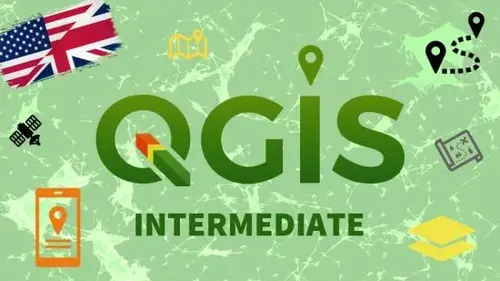Intermediate GIS in QGIS 3
geometry geoprocessing, GPX, KML and maps in Google

What you'll learn
Working in QGIS 3
Working on spatial data
Creating frames and data indexes
Projection and mapping
Geometry analysis and editing
KML
Creating geoprocessing models
Workflow automation
Iteration
Finding the shortest path
Designating access routes
Sampling raster data to points
Creating Google maps project
Google map layers
KML processing, export and import
Solving the same problem with different methods
Requirements
Knowledge of the basics of working in QGIS 3
Basics of working with spatial data
Style settings and data visualization
Knowledge of the types and tools for spatial data analysis
Description
The intermediate GIS in QGIS 3 course is dedicated for people who already know the basics of working in the QGIS 3 environment and want to expand their skills in the field of spatial data analysis and processing.
During the course you will learn more advanced techniques of working with data. You will learn how to create data frames and extract raster data from them, how to create indexes, and what happens when we mess up the coordinate systems. You will delve into the issues of data geometry analysis and you will learn how to create geoprocessing models and automate your work in QGIS. You will see how to approach the linear route analysis problem, how to sample raster values to vector geometry and calculate slopes based on them. At the end of the course, you will learn about the KML files and data, as well as how to create and use it in Google Maps.
During the course, we will work on solving the problem presented at the beginning of the course. The course is designed in such a way that various errors and problems arise as you work, so you will see how to deal in different ways with possible problems that you may encounter in your future work.
In order to efficiently implement the scope and content of the course, you should know the basics of working in the QGIS 3 software, in particular the issues of geoprocessing, visualization and data digitization - all these issues are discussed at the basic level of the course.
The course is based on free QGIS software, in the latest, 3rd version, and publicly available spatial data. Thanks to the Open-Source license, QGIS is widely used by many companies, both state-owned and in the private sector. The environment is constantly being developed, updated and regularly translated into many languages. The multitude of available data analysis options makes it one of the most popular GIS programs in the world!
Who this course is for
Students
Spatial analysts
People interested in analyzing spatial data
People interested in GIS
Public administration
Anyone who wants to expand their knowledge or learn something new
MP4 | Video: h264, 1280x720 | Audio: AAC, 44.1 KHz, 2 Ch
Genre: eLearning | Language: English + srt | Duration: 57 lectures (7h 7m) | Size: 3.96 GB
Download
http://s9.alxa.net/one/2024/10/Inter....in.QGIS.3.rar
geometry geoprocessing, GPX, KML and maps in Google

What you'll learn
Working in QGIS 3
Working on spatial data
Creating frames and data indexes
Projection and mapping
Geometry analysis and editing
KML
Creating geoprocessing models
Workflow automation
Iteration
Finding the shortest path
Designating access routes
Sampling raster data to points
Creating Google maps project
Google map layers
KML processing, export and import
Solving the same problem with different methods
Requirements
Knowledge of the basics of working in QGIS 3
Basics of working with spatial data
Style settings and data visualization
Knowledge of the types and tools for spatial data analysis
Description
The intermediate GIS in QGIS 3 course is dedicated for people who already know the basics of working in the QGIS 3 environment and want to expand their skills in the field of spatial data analysis and processing.
During the course you will learn more advanced techniques of working with data. You will learn how to create data frames and extract raster data from them, how to create indexes, and what happens when we mess up the coordinate systems. You will delve into the issues of data geometry analysis and you will learn how to create geoprocessing models and automate your work in QGIS. You will see how to approach the linear route analysis problem, how to sample raster values to vector geometry and calculate slopes based on them. At the end of the course, you will learn about the KML files and data, as well as how to create and use it in Google Maps.
During the course, we will work on solving the problem presented at the beginning of the course. The course is designed in such a way that various errors and problems arise as you work, so you will see how to deal in different ways with possible problems that you may encounter in your future work.
In order to efficiently implement the scope and content of the course, you should know the basics of working in the QGIS 3 software, in particular the issues of geoprocessing, visualization and data digitization - all these issues are discussed at the basic level of the course.
The course is based on free QGIS software, in the latest, 3rd version, and publicly available spatial data. Thanks to the Open-Source license, QGIS is widely used by many companies, both state-owned and in the private sector. The environment is constantly being developed, updated and regularly translated into many languages. The multitude of available data analysis options makes it one of the most popular GIS programs in the world!
Who this course is for
Students
Spatial analysts
People interested in analyzing spatial data
People interested in GIS
Public administration
Anyone who wants to expand their knowledge or learn something new
MP4 | Video: h264, 1280x720 | Audio: AAC, 44.1 KHz, 2 Ch
Genre: eLearning | Language: English + srt | Duration: 57 lectures (7h 7m) | Size: 3.96 GB
Download
http://s9.alxa.net/one/2024/10/Inter....in.QGIS.3.rar